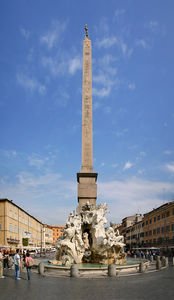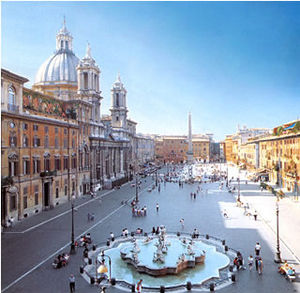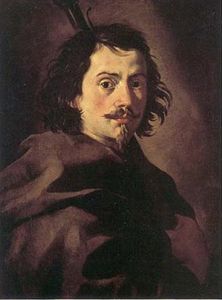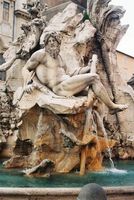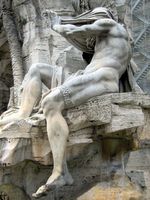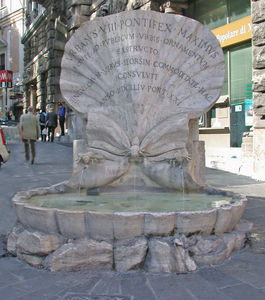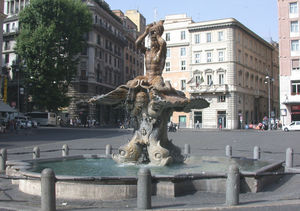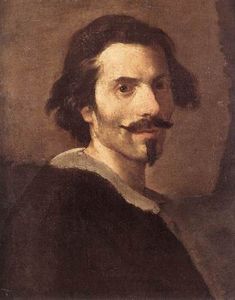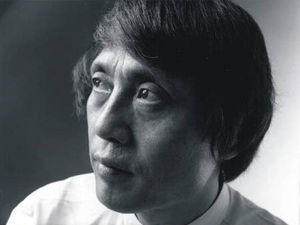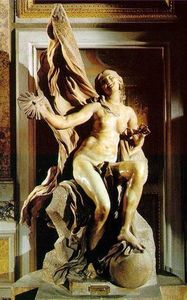Fountain of the Four Rivers
- Alternative Names:
- Fontana dei Quattro Fiumi
- Date of Creation:
- 1651
- Medium:
- Stone
- Subject:
- Figure
- Art Movement:
- Baroque
- Created By:
- Current Location:
- Rome, Italy
- Fountain of the Four Rivers Page's Content
- Story / Theme
- Analysis
- Related Sculptures
- Artist
- Art Period
- Bibliography
Fountain of the Four Rivers Story / Theme
Fast fact:
Part of the fountain is made from travertine, a hard white rock from Tivoli, Italy. The Coliseum and the Sacre-Coeur in Paris are also made of travertine
-

Piazza Navona
Bernini
Although Bernini gets all the credit, the majority of the actual construction of the fountain was carried out by his assistants; Bernini was only responsible for the design. This was common practice for the time: major artists like Bernini could not possibly complete all their commissions by themselves, and needed an army of helpers to finish them in a timely fashion
-

Francesco Borromini
The Fountain of the Four Rivers is also known as The Fontana dei Quattro Fiumi and is located in the Piazza Navona in Rome. The fountain was an important source of potable water for the locals before the days of indoor plumbing, but even more importantly it was a grandiose monument to the power and glory of the pope and his family. The fountain is built around a slender Egyptian obelisk surmounted by a dove, a symbol both of the church and the Pamphilij (the papal family). The surrounding sculptures represent the four major rivers of the four continents that were recognized at that time;
The Ganges in Asia: This apathetic river god looks away from the light of the Church, representing the spiritual ignorance of this hedonistic land
The Río de la Plata in America: Although he throws his hands back in surprise, this representative of the newly converted lands has begun to see the light
The Danube in Europe: The most "civilized" and cultured of the figures, the Danube looks toward and embraces the light of the lord.
The Nile in Africa: Bernini depicts the Nile with its head covered because at that time, the source of the river was unknown. Symbolically, this also refers to what the Catholic world saw as the dark ignorance of the "pagan" world: the sculpture has not seen the light of Christianity
The Commission:
Bernini's triumphant Fountain of the Four Rivers was commissioned in 1648 by Pope Innocent X, who initially refused to consider Bernini for the project, favoring arch-rival Borromini instead after the disastrous bell-tower incident that nearly ruined Bernini's reputation.
Bernini's biographer Filippo Baldinucci describes how the artist's close friend Niccolò Ludovisi ensnared the pope into giving Bernini the commission;
"So strong was the sinister influence of the rivals of Bernini on the mind of Innocent X that when he planned to set up in Piazza Navona the great obelisk brought to Rome by the Emperor Caracalla which had been buried for a long time at Capo di Bove for the adornment of a magnificent fountain, the Pope had designs made by the leading architects of Rome without an order for one to Bernini. Prince Niccolò Ludovisi, whose wife was niece to the pope, persuaded Bernini to prepare a model, and arrange for it to be secretly installed in a room in the Palazzo Pamphilj which the Pope had to pass. When the meal was finished, seeing such a noble creation, he stopped almost in ecstasy. Being prince of the keenest judgment and the loftiest ideas, after admiring it, said: "This is a trick ... It will be necessary to employ Bernini in spite of those who do not wish it, for he who desires not to use Bernini's designs, must take care not to see them."
Fountain of the Four Rivers Analysis
With the Fountain of the Four Rivers Bernini has once again constructed a monument without precedent. Contemporary writers describe the triumphant and theatrical unveiling of the monument to the city of Rome, and the astonishment of the people at the natural, true-to-life figures.
Theatricality:
The fountain is the epitome of Baroque theatricality. Some have described it as a kind of theatre in the round, with the highly dramatic, evocative, and individualized figures, the dramatically spurting water, and a wealth of surprising and charming sculptural details. The work influenced the shape of Italian fountains for the entire century to come.
Features:
The marble Gods are part of a scene filled with flowers and animals. Seven animals are positioned around the fountain and include; a horse, a sea monster, a serpent, a dolphin, a crocodile, a lion and a dragon. At the top of the obelisk there is a dove, symbolizing the Holy Spirit and motif of the pope that commissioned this piece.
Unveiling:
It's believed that the construction of this fountain was met with disapproval by the people of Rome for various reasons. Firstly, it was built and paid for by the public during the famine of 1646-48. Some writers attached notes to the fountain as it was being built that said "We do not want Obelisks and Fountains, It is bread that we want. Bread, Bread, Bread!" The pope had these writers arrested and he hired people to patrol the Piazza Navona and deal with any trouble. Streetvendors from the market in the piazza are also believed to have protested about it, believing it detracted from the beauty of the piazza itself. They were eventually chased from the square by the papal police.
Fountain of the Four Rivers Related Sculptures
Fountain of the Four Rivers Artist
This Fountain of the Four Rivers is probably the most beloved of Bernini's Roman fountains. A veritable "theatre in the round," the dramatic water fountains and sensational sculptural details continue to delight viewers centuries after its construction. Bernini's talent forever changed the face of the city of Rome and single-handedly launched the style that would dominate seventeenth-century Italian sculpture.
During his career Bernini had no shortage of commissions, much to the annoyance of other artists and imitators. He was one of the most admired and sought-after of artists, with the highest of reputations. Italian and French contemporaries praised the artist with detailed biographies, sure of the genius in their midst.
Naturally Bernini had his fair share of devoted followers, such as Tadao Ando. From contemporaries who worked directly under him or competed with him for commissions, up to modern artists who looked to his use of emotional multimedia design for inspiration, a multitude of artists can thank Bernini for the development of their own styles.
However in the backlash against the Baroque that occurred with the advent of Neoclassicism, the accolades faded into harsher criticisms.
Though the Baroque and Bernini along with it went out of fashion for a long period of time, in the 20th century he was "rediscovered" as a true master of realism and emotion, earning a renewed respect and influence on a new generation of artists, which continues up until this day.
Fountain of the Four Rivers Art Period
Bernini's career spans the height of the Italian Baroque. Baroque art is profoundly tied to the religious and political context of 16th and 17th century Italy: after the Protestant Reformation, the Catholic Church launched its own Counter-Reformation to reaffirm its power and attract more followers to the faith.
In order to do so, the leaders of the church called for artistic spectacles that would captivate the attention, stimulate the senses, and elevate the soul: in consequence, Baroque art tends to the massive, dramatic, and theatrical.
Bernini's sculptures are recognizable for their theatrical, engaging drama, dynamism, tension, texture, and naturalism. The last two criteria (texture and naturalism) are perhaps the most particular to Bernini: no one can make stone convey soft skin, curling hair, or crinkling fabrics the way Bernini can.
His sculptures are also unique for the careful attention Bernini pays to the effects of light and shadow, effects which are traditionally more important to the painter than the sculptor. Many elements of Bernini's style reveal the influence of Mannerist and Hellenistic sculpture.
Fountain of the Four Rivers Bibliography
Some of the most important academic resources on Bernini and his works include the following;
• Bauer, George, ed. Bernini in Perspective. Prentice-Hall, 1976
• Borsi, Franco. Bernini. Trans. Robert Erich Wolf. Rizzoli, 1984
• Gould, Cecil. Bernini in France: An Episode in Seventeenth-Century History. Weidenfeld and Nicolson, 1981
• Hibbard, Howard. Bernini. Penguin Books, 1965
• Lavin, Irving. Bernini and the Unity of the Visual Arts. For Pierpont Morgan Library by Oxford University Press, 1980
• Magnuson, Torgil. Rome in the Age of Bernini. Almqvist & Wiksell International
• Morissey, J. P. The Genius in the Design: Bernini, Borromini, and the Rivalry that Transformed Rome. Duckworth, 2005
• Wittkower, Rudolf. Gian Lorenzo Bernini: The Sculptor of the Roman Baroque. Cornell University Press, 1981

